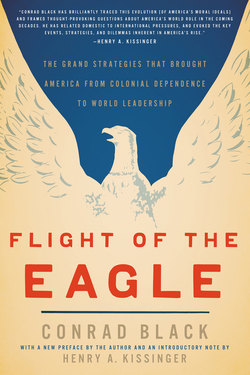Flight of the Eagle

Реклама. ООО «ЛитРес», ИНН: 7719571260.
Оглавление
Conrad Black. Flight of the Eagle
Отрывок из книги
Acclaim for
FLIGHT OF THE EAGLE
.....
Greene found the wreckage of Gates’s army, 1,400 “naked and dispirited” troops, at Hillsboro, on November 27, 1780, where the hero of Saratoga had fled after the Camden rout. He faced the British commander, the competent nephew of Prime Minister Robert Walpole, Lord Cornwallis, who had performed well throughout the Revolutionary War in various commands, and had shattered Gates at Camden. What was later reckoned, in Jefferson’s pious words, “That joyful annunciation of that turn in the tide of success which ended the Revolutionary War” occurred on November 27, 1980, at King’s Mountain, on the border between the Carolinas. A little over a thousand British and loyalists commanded by a fierce Scot, Patrick Ferguson, met 1,400 “overmountain” men, virtual hillbillies, commanded by their militia-leading landlords, John Sevier and Isaac Shelby, and almost the entire British force was killed or captured. The overmountain men were tall and lean and agile, had matted hair, and seemed like savages to their enemies, and behaved accordingly. The rulebook having been dispensed with by Tarleton at Waxhaw, the Americans massacred many of the British and left many more to be eaten by wolves. They marched 700 prisoners off, but many of those perished also. The small and almost inadvertent engagement demonstrated, as would many sequels in other distant partly colonial, partly guerrilla wars, that the side that is in revolt only has to win occasionally to keep the fires burning, and the overseas power becomes easily demoralized by any defeat.
The British were now facing not only the war’s most able field commander in Greene and his deputy, Daniel Morgan, but also guerrilla warriors of genius, in Thomas Sumter and especially General Francis “Swamp Fox” Marion. Cornwallis moved cautiously from Camden toward Charlotte, and in January 1781, after the setback at King’s Mountain, he sent Tarleton to deal with the very able Morgan, while he went into North Carolina after Greene. Tarleton charged impetuously uphill after Morgan, at Cowpens on January 13. Morgan had 200 militiamen fire twice and then retreat as if in rout, and as the British reached the crest of the hill, in probably the most finely executed action of the war, Morgan’s main force poured fire onto the British, who broke and retreated, with the Americans on their heels. Tarleton bravely fought to the end, and was finally chased off with only 40 survivors, having lost over a thousand men to the Americans, who sustained only 70 casualties. Both armies regrouped and their combined forces met at Guilford Court House, North Carolina, on March 15, 1781, and Cornwallis did well to repel Greene, though outnumbered. It was not a decisive victory and the British lost 500 men to 300 American casualties. (Loyalists fighting with the British, when captured, often received a very rough and not infrequently mortal treatment; it had become a very nasty war.)
.....